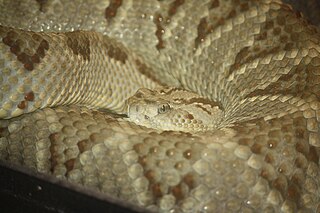
Crotalus is a genus of pit vipers, commonly known as rattlesnakes or rattlers, in the family Viperidae. The genus is found only in the Americas from southern Canada to northern Argentina. The generic name Crotalus is derived from the Greek word κρόταλονkrótalοn, which means "rattle" or "castanet", and refers to the rattle on the end of the tail, which makes this group so distinctive. As of July 2023, 44 to 53 species are recognized as valid.

Convulxin is a snake venom toxin found in a tropical rattlesnake known as Crotalus durissus terrificus. It belongs to the family of hemotoxins, which destroy red blood cells or, as is the case with convulxin, induce blood coagulation.

Crotalus basiliscus, known as the Mexican west coast rattlesnake, Mexican green rattler, and also by other names, is a species of pit viper in the family Viperidae. The species is endemic to western Mexico. Like all other pit vipers, it is venomous. The specific name, basiliscus, is derived from the Greek word for king, βασιλισκος, and alludes to this snake's large size and potent venom. No subspecies are currently recognized.

Myotoxins are small, basic peptides found in snake venoms and lizard venoms. This involves a non-enzymatic mechanism that leads to severe muscle necrosis. These peptides act very quickly, causing instantaneous paralysis to prevent prey from escaping and eventually death due to diaphragmatic paralysis.

Crotalus durissus, known as the South American rattlesnake, tropical rattlesnake, and by other names, is a highly venomous pit viper species found in South America. It is the most widely distributed member of its genus. Currently, seven subspecies are recognized.

Crotalus simus is a venomous pit viper species found in Mexico and Central America. The specific epithet is Latin for "flat-nosed", likely because its head is blunt compared with lanceheads (Bothrops). Three subspecies are recognized, including the nominate subspecies described here.

The Aruba Island rattlesnake, is a venomous pit viper species endemic to the Caribbean island of Aruba, off the coast of Venezuela. It is sometimes still classified as a subspecies of Crotalus durissus.
Crotalus durissus neoleonensis may refer to:

Crotamine is a toxin present in the venom of the South American rattlesnake. It is a 42-residue-long protein containing 11 basic residues and six cysteines. It has also been isolated from the venom of North American prairie rattlesnake, Crotalus viridis viridis. It was first isolated and purified by Brazilian scientist José Moura Gonçalves, and later intensively studied by his group of collaborators at the Medical School of Ribeirão Preto of the University of São Paulo.
Crotalus totonacus is a venomous pit viper species found in northeastern Mexico. No subspecies are currently recognized.
The fauna of Uruguay is a part of the wildlife of Uruguay.
Hepatozoon cuestensis is a species of alveolates known to infect snake species such as Crotalus durissus terrificus (rattlesnake).
Hepatozoon cevapii is a species of alveolates protists known to infect snake species such as Crotalus durissus terrificus (rattlesnake).
Crotoxin (CTX) is the main toxic compound in the snake venom of the South American rattlesnake, Crotalus durissus terrificus. Crotoxin is a heterodimeric beta-neurotoxin, composed of an acidic, non-toxic and non-enzymatic subunit (CA), and a basic, weakly toxic, phospholipase A2 protein (CB). This neurotoxin causes paralysis by both pre- and postsynaptic blocking of acetylcholine signalling.

Snakebite envenomation is considered a public health problem in Latin America, with an estimated 70,000 cases annually, but due to underreporting, these numbers may be even higher.

Crotalus tzabcan, the Yucatán neotropical rattlesnake, is a species of pit viper in the family Viperidae. It was previously thought to be a subspecies of Crotalus durissus, until Wüster elevated it to species status in 2005.

Crotalus durissus cumanensis is a subspecies of venomous pit viper from Colombia and Venezuela. They account for 1-3% of all snake bites in Colombia.
Crotalus durissus maricelae, the Maricela rattlesnake, is a subspecies of venomous pit viper from Venezuela.
Crotalus durissus ruruima is a subspecies of venomous pit viper from Brazil. It is restricted mainly to the savannah regions of Roraima, however it has been recorded in the Apiaú region possibly due to the deforestation of its natural range.









